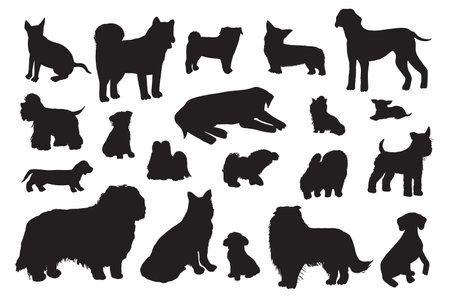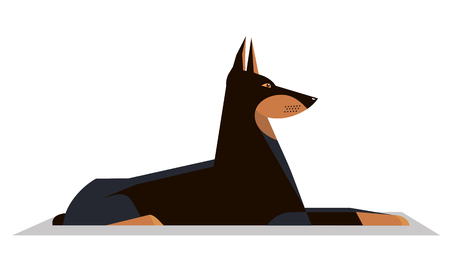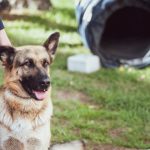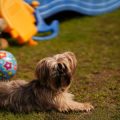Introduction to Dog Coat Types
Dog lovers across the United States encounter an incredible variety of dog breeds, each with its own unique coat type. From the curly locks of a Poodle to the smooth fur of a Beagle, understanding these differences is more than just a matter of looks—it’s essential for your dog’s health and happiness. The most common coat types found in America include short coats, long coats, double coats, wire coats, curly coats, and hairless varieties. Each type comes with its own grooming needs, which can affect everything from how much your dog sheds to how often you need to brush or bathe them. Knowing what kind of coat your dog has helps you provide the right care, prevent matting and skin issues, and keep your pup comfortable year-round. In this guide, we’ll break down the main coat types you’ll find in American homes and explain why it’s so important for every pet parent to recognize their dog’s specific grooming requirements.
2. Short-Haired Coats
Short-haired dog breeds are among the most popular choices for American families due to their low-maintenance appearance and friendly temperaments. Breeds like Beagles and Boxers are prime examples, both commonly found in households across the United States. Understanding what makes these coats unique and how to care for them helps ensure your pet remains healthy and comfortable.
Characteristics of Short-Haired Breeds
Short-haired dogs have fur that typically lies flat against the body, rarely growing longer than an inch. This type of coat offers some protection against dirt and moderate weather, but it won’t provide insulation in extreme cold. Beagles, with their smooth double-coat, and Boxers, who sport a single, sleek layer, demonstrate the variety within short-haired breeds.
Grooming Needs
| Breed Example | Shedding Level | Brushing Frequency | Special Care Notes |
|---|---|---|---|
| Beagle | Moderate | Once a week | Watch for seasonal shedding in spring/fall |
| Boxer | Low-Moderate | Once a week | Bathe only when dirty; check skin folds |
Practical Grooming Tips for American Dog Owners
- Weekly brushing: Use a rubber curry brush or grooming mitt to remove loose hair and stimulate natural oils—perfect for busy lifestyles common in American households.
- Bath time: Most short-haired dogs only need a bath every few months unless they roll in something messy (think backyard barbecues or muddy hikes).
- Paw and ear checks: Especially after outdoor activities or park visits, check for ticks, burrs, or other debris.
- Skin health: Because their coats don’t hide much, keep an eye out for rashes or hot spots—issues that can be more obvious on breeds like Boxers.
- Seasonal shedding: Expect increased hair loss during spring and fall; regular vacuuming is your best friend!
The Bottom Line for Short-Haired Breeds in America
If you own a short-haired breed like a Beagle or Boxer, grooming is straightforward but still essential. Regular maintenance not only keeps your dog looking sharp but also supports overall health—a win-win for you and your four-legged family member.

3. Long-Haired Coats
Long-haired dogs like Golden Retrievers and Shih Tzus have beautiful, flowing coats that require special attention to keep them healthy and tangle-free. These breeds are prone to matting, which can lead to discomfort and even skin problems if not addressed regularly. The main challenge with long-haired coats is preventing tangles and mats before they start, especially in high-friction areas like behind the ears, under the legs, and around the tail.
Typical Challenges
Owners of long-haired dogs often face daily shedding, dirt accumulation, and tangling. Outdoor activities can make things worse, as leaves, burrs, and debris easily get caught in their fur. In humid or rainy climates, these issues can multiply, making grooming an essential part of your routine rather than an occasional task.
Essential Grooming Routines
Brushing Techniques
For long-haired breeds, brushing several times a week—ideally daily—is recommended. Use a slicker brush or a pin brush to gently work through knots, starting from the ends of the hair and working up towards the roots. For stubborn mats, use a dematting tool or seek professional help rather than pulling hard on your dogs coat, which can cause pain or injury.
Professional Grooming Frequency
Long-haired dogs benefit from regular visits to professional groomers every 4-8 weeks. Groomers can perform thorough trims, sanitary cuts (especially important for Shih Tzus), nail clipping, ear cleaning, and remove any mats you may have missed at home. Regular grooming also helps spot skin conditions or parasites early on.
Pro Tip
Start grooming routines when your dog is young so they get used to being handled. Use treats and calm praise to make grooming sessions positive experiences. Investing in quality tools designed for long-haired breeds will save you time—and prevent frustration for both you and your pup!
4. Curly and Wavy Coats
Breeds like Poodles and Labradoodles are famous for their curly or wavy coats. While these coats look adorable and are often considered hypoallergenic, they require a specific grooming routine to stay healthy and tangle-free. If you’re a pet parent in the U.S., understanding how to care for these coat types will help your dog look and feel its best.
How to Care for Curly and Wavy Coats
Curly and wavy coats are prone to matting if not brushed regularly. Mats can cause discomfort, skin irritation, and even infections. To avoid this, establish a grooming schedule that fits your lifestyle and your dog’s needs. Here’s a practical guide:
| Task | Frequency | Recommended Tools (Available at U.S. Pet Stores) |
|---|---|---|
| Brushing/Detangling | Daily to every other day | Slicker brush, detangling spray, steel comb |
| Bathing | Every 3-4 weeks | Mild dog shampoo for sensitive skin |
| Professional Grooming/Haircuts | Every 6-8 weeks | N/A (visit a groomer) |
Detangling and Preventing Matting
Always start by gently working through tangles with your fingers before using a slicker brush or steel comb. For stubborn mats, apply a detangling spray—these are widely sold in most American pet stores such as Petco, PetSmart, or even local grocery chains. Never pull harshly; instead, work slowly from the ends toward the skin to minimize discomfort.
Product Recommendations You’ll Find Easily in the U.S.
Look for brands like “FURminator,” “Hartz Groomer’s Best,” or “Burt’s Bees” when shopping for brushes and sprays. Most of these products are formulated for sensitive skin and designed to make regular maintenance easier for both you and your pup.
A consistent routine not only keeps curly and wavy coats neat but also helps build trust between you and your dog during grooming sessions. By using the right tools and techniques, you’ll prevent mats before they start and ensure your furry friend stays comfortable year-round.
5. Double-Coated Breeds
If you share your home with a Husky, German Shepherd, or another double-coated breed, you know that their impressive fur comes with unique grooming needs. Double coats consist of a soft, insulating undercoat and a tougher outer layer, which help these dogs regulate temperature throughout the year. Understanding how to care for this type of coat is crucial for your pet’s health and comfort.
Shedding: What to Expect
Double-coated breeds experience seasonal “blowouts”—periods in spring and fall when they shed their undercoat heavily. During these times, expect tufts of fur everywhere! Regular brushing with an undercoat rake or de-shedding tool can help manage the shedding and keep your dog comfortable.
Essential Grooming Tips
- Brush Frequently: Aim for at least 2-3 times a week during normal seasons and daily during heavy shedding periods.
- Bathe Sparingly: Bathe only as needed (every couple of months), as overbathing can strip essential oils from their skin and coat.
Do’s and Don’ts of Seasonal Coat Care
- Do: Use the right tools—an undercoat rake or slicker brush works best for removing loose fur without damaging the topcoat.
- Do: Be patient. Shedding season can be intense, but regular grooming makes a big difference.
- Don’t: Shave your double-coated dog! Their two-layered fur protects them from both cold and heat; shaving can disrupt this natural insulation and may cause long-term coat damage.
Real-World Example
For instance, American families with Huskies often find themselves vacuuming more during spring. Instead of fighting the fur alone, make brushing part of your routine—many owners set up “shedding stations” in their garage or backyard so cleanup is easier. Consistent grooming not only keeps your home cleaner but also strengthens the bond between you and your dog while supporting their health.
6. Special Considerations for Mixed Breeds
If you’re the proud parent of a mixed-breed dog, grooming can be both exciting and a little confusing. That’s because your pup’s coat may blend traits from multiple breeds—think poodle curls mixed with retriever waves or terrier wiriness paired with spaniel softness. Understanding how to care for these unique coats means paying close attention and being ready to adjust your routine as needed.
Why Mixed-Breed Coats Are Unique
Mixed-breed dogs often inherit a combination of coat textures, lengths, and shedding patterns. For example, you might notice your dog has a thick undercoat in some areas and silky fur elsewhere. This variety calls for a more tailored approach to grooming, compared to purebred dogs with standard coat types.
Action Steps for Grooming Your Mixed-Breed Dog
1. Observe and Identify Coat Traits
Start by examining your dog’s fur: Is it curly, straight, wiry, or double-layered? Does it mat easily or shed a lot? Take note of different textures across their body.
2. Choose the Right Tools
Based on what you observe, select brushes and combs that match those specific needs. For example, use a slicker brush for detangling curly patches and an undercoat rake for thicker areas.
3. Customize Bathing Frequency
Some mixed-breeds need frequent baths if they have oily or dirt-prone coats; others do best with less frequent washing to avoid drying out their skin. Adjust based on how your dog looks and feels after each bath.
4. Pay Attention to Problem Areas
Mats and tangles can form behind ears, under legs, or wherever two coat types meet. Set aside extra time to gently work through these spots during each grooming session.
5. Consult a Professional When Needed
If you’re unsure about your dog’s coat type—or if they seem uncomfortable—schedule an appointment with a professional groomer experienced with mixed breeds. They can recommend specific techniques or demonstrate the best tools for your unique pup.
The Bottom Line
No two mixed-breed coats are exactly alike, so there’s no one-size-fits-all approach. By observing your dog’s specific needs and adjusting your grooming habits accordingly, you’ll keep their coat healthy—and strengthen the bond you share in the process.
7. Conclusion: Building the Right Grooming Routine
Understanding your dog’s coat type is the first step toward creating an effective grooming routine that fits both your pet’s needs and your American lifestyle. To assess your dog’s individual requirements, take note of their breed, age, activity level, and how their coat responds to various grooming techniques. For example, a Golden Retriever may need weekly de-shedding sessions due to their double coat, while a Poodle with a curly coat benefits from regular trims and daily brushing to prevent mats.
Start by observing how often your dog gets dirty or tangled during typical activities like walks in the park or hikes on local trails. This will help you decide if you need to bathe them monthly or more frequently, which is common for active dogs in suburban or rural areas. Create a simple calendar or set reminders on your phone to keep track of brushing, bathing, nail trimming, and ear cleaning. Many American pet parents find it helpful to integrate grooming into existing routines—such as brushing after evening walks or scheduling baths on weekends when the whole family can participate.
If you encounter persistent tangles, skin irritation, or if your dog resists home grooming, don’t hesitate to seek professional help. Local groomers are familiar with breed standards and can give you tips tailored to American weather conditions and seasonal challenges. They can also teach you safe handling techniques and recommend products suited for your dog’s specific coat type.
Ultimately, building a consistent grooming routine is about paying attention to your dog’s comfort and health while making it manageable within your busy schedule. Involving family members, using positive reinforcement, and making grooming a bonding time can turn this chore into an enjoyable part of daily life in America.


